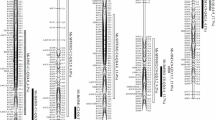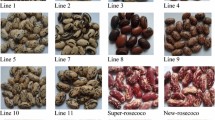Summary
Bean lines PI 165426, PI 165435, and Alabama no. 1, possessing resistance to Meloidogyne incognita, and bean lines A315 and A445, possessing gene Me1, were tested against several Meloidogyne incognita and M. javanica isolates. Resistance in bean line PI 165426, PI 165435, and Alabama no. 1 was found to be complementary to resistance conferred by gene Me1. Resistance in PI 165426 was found to be dominant and conditioned by one dominant and one recessive gene at 26 °C. We propose Me2me3 as the genotype symbol for this resistance. Resistance in lines PI 165435 and Alabama no. 1 was found to be recessive. Since Alabama no. 1 and PI 165435 were resistant at 26 °C but susceptible at 29 °C, and segregation of F2 progeny derived from crosses involving PI 165426 was 13∶3 at 26 °C and 1∶2∶1 at 28 °C, we concluded that the temperature at which transition from resistance to susceptibility occurs was determined by whether the resistance gene is dominant or recessive. Furthermore, the 1∶2∶1 segregation of F2 plants and an intermediate resistance reaction of F1 plants of crosses involving PI 165426 indicated that allelic dosage of the dominant gene also influenced the transition temperature.
Similar content being viewed by others
References
Ammati M, Thomason IJ, McKinney HE (1986) Retention of resistance to Meloidogyne incognita in Lycopersicon genotypes at high soil temperature. J Nematol 18:491–495
Barrons KC (1939) Root-knot resistance in beans. J Hered 31:35–38
Clayton JW, Tretiak DN (1972) Amine-citrate buffers for pH control in starch gel electrophoresis. J Fish Res Bd Canada 29:1169–1172
Dropkin VH (1969) The necrotic reaction of tomatoes and other hosts resistant to Meloidogyne: reversal by temperature. Phytopathology 59:1632–1637
Esbenshade PR, Triantaphyllou AC (1985) Electrophoretic methods for the study of root-knot nematode enzymes. In: Barker KR, Carter CC, Sasser JN (eds) An advanced treatise on Meloidogyne, Vol. 2: Methodology. North Carolina State University Graphics, Raleigh, pp 115–123
Fassuliotis G, Deakin JR, Huffman JC (1970) Root-knot nematode resistance in snap bean: breeding and nature of resistance. J Am Hortic Sci 95:640–645
Griffin GD (1969) Effects of temperature on Meloidogyne hapla in alfalfa. Phytopathology 59:599–609
Hartman KM, Sasser JN (1985) Identification of Meloidogyne species on the basis of differential host test and perineal pattern morphology. In Barker KR, Carter CC, Sasser JN (eds) An advanced treatise on Meloidogyne, Vol. 2: Methodology. North Carolina State University Graphics, Raleigh, pp 69–77
Hartmann RW (1970) Inheritance of resistance to root-knot nematodes (Meloidogyne incognita) in beans (Phaseolus vulgaris). J Am Soc Hortic Sci 96:344–347
Hussey RS, Barker KR (1973) A comparison of methods of collecting inocula of Meloidogyne spp. including a new technique. Plant Dis Rep 57:1020–1023
Islam MR, Sheperd KW, Mayo GME (1989) Effect of genotype and temperature on the expression of L genes in flax conferring resistance to rust. Physiol Mol Plant Pathol 35:141–151
Luig NH, Rajaram S (1972) The effect of temperature and genetic background on host gene expression and interaction to Puccinia graminis tritici. Phytopathology 62:1171–1174
Marty TI, O'Malley DM, Guries RP (1984) A manual for starch gel electrophoresis. University of Wisconsin, Department of Forestry Staff Paper Series No. 20 (1984) Madison/WI
Mullin BA, Abawi GS, Pastor-Corrales MA (1991) Modification of resistance expression of Phaseolus vulgaris to Meloidogyne incognita by elevated soil temperatures. J Nematol 23:182–187
Omwega CO, Thomason IJ, Roberts PA (1988) A nondestructive technique for screening bean germ plasm for resistance to Meloidogyne incognita. Plant Dis 72:970–972
Omwega CO, Thomason IJ, Roberts PA (1990a). A single dominant gene in common bean conferring resistance to three root-knot nematode species. Phytopathology 80:745–748
Omwega CO, Thomason IJ, Roberts PA (1990b) Effect of temperature on expression of resistance to Meloidogyne spp. in common bean (Phaseolus vulgaris). J Nematol 22:446–451
Omwega CO, Thomason IJ, Roberts PA, Waines JG (1989) Identification of new sources of resistance to root-knot nematodes in Phaseolus. Crop Sci 29:1463–1468
Seiander RK, Smith MH, Yang SY, Johnson WE, Gentry JB (1971) Biochemical polymorphism and systematics in the genus Peromyscus. I. Variation in the old-field mouse (Peromyscus polionotus). Studies in Genetics VI. Univ Texas Publ 7103:49–90
Tyler JM, Hatchett JH (1983) Temperature influence on expression of resistance to Hessian fly (Diptera:Cecidomyiidae) in wheat derived from Triticum tauschii. J Econ Entomol 76:323–326
Weeden NF (1984) Distinguishing among white-seeded bean cultivars by means of allozyme genotypes. Euphytica 33:199–208
Author information
Authors and Affiliations
Additional information
Communicated by G. Wenzel
Rights and permissions
About this article
Cite this article
Omwega, C.O., Roberts, P.A. Inheritance of resistance to Meloidogyne spp. in common bean and the genetic basis of its sensitivity to temperature. Theoret. Appl. Genetics 83, 720–726 (1992). https://doi.org/10.1007/BF00226690
Received:
Accepted:
Issue Date:
DOI: https://doi.org/10.1007/BF00226690




